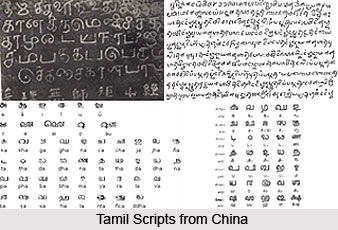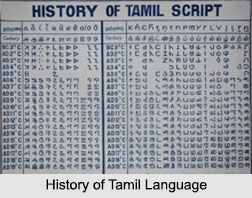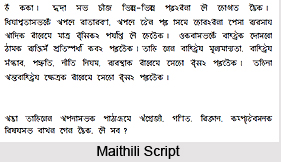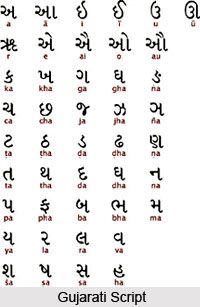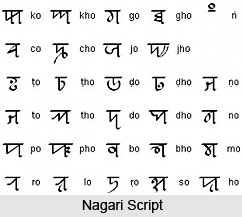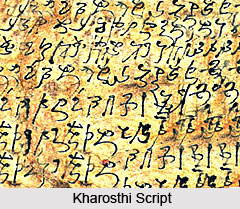 Kharosthi script is also acknowledged as Gandhari script, which represents an ancient abugida (or "alphasyllabary"). Abudiga, in the Kharosthi script context, stands for each letter exemplifying a consonant, whereas vowels are written with mandatory diacritics. Kharosthi was enormously utilised by the Gandhara ethnicity of present-day Pakistan (which was formerly an integral part of undivided Indian subcontinent), lying in the historic northwest Asian subcontinent, to pen down Gandhari and Sanskrit languages. The script was in use from the middle of the 3rd century B.C.E. until it became extinct in its homeland approximately during the 3rd century C.E. It was also in use during Kushan (referring to the Kushana Empire), Sogdiana (ancient civilisation of Iranian people and a province of the Achaemenid Persian Empire) and along the Silk Road (also admired as Silk Routes, this represents a far-reaching interlinked chain of trade routes spanning the Asian continent). There exists some evidence in these mentioned places, that Kharosthi script might have survived until the 7th century in the far-flung way stations of Khotan and Niya.
Kharosthi script is also acknowledged as Gandhari script, which represents an ancient abugida (or "alphasyllabary"). Abudiga, in the Kharosthi script context, stands for each letter exemplifying a consonant, whereas vowels are written with mandatory diacritics. Kharosthi was enormously utilised by the Gandhara ethnicity of present-day Pakistan (which was formerly an integral part of undivided Indian subcontinent), lying in the historic northwest Asian subcontinent, to pen down Gandhari and Sanskrit languages. The script was in use from the middle of the 3rd century B.C.E. until it became extinct in its homeland approximately during the 3rd century C.E. It was also in use during Kushan (referring to the Kushana Empire), Sogdiana (ancient civilisation of Iranian people and a province of the Achaemenid Persian Empire) and along the Silk Road (also admired as Silk Routes, this represents a far-reaching interlinked chain of trade routes spanning the Asian continent). There exists some evidence in these mentioned places, that Kharosthi script might have survived until the 7th century in the far-flung way stations of Khotan and Niya.
During modern historical eras, the Kharosthi script was first decrypted by James Prinsep (1799-1840), by employing the bilingual coins of the Indo-Greeks (Obverse in Greek, reverse in Pali, using the Kharosthi script). This in succession led to the interpretation of the Rock Edicts of Ashoka, some of which, from the northwest of the Asian subcontinent, were penned in the Kharosthi script.
However, historians and scholars stand in absolute discrepancy as to whether the Kharosthi script at all evolved gradually, or was a premeditated work of a single artificer. An examination and study of the script forms shows a distinct dependency on the Aramaic alphabet, but with panoptic alterations to support the sounds observed in Indic languages. One model is that the Aramaic script made its entrance with the Achaemenid conquest of the region of Pakistan in 500 B.C.E. and developed over the next 200 and more years to reach its culminating form by the 3rd century B.C.E. During this precise period, Kharosthi had appeared in some of the Rock Edicts of Ashoka unearthed in northwestern part of the Asian subcontinent, markedly in Pakistan and Afghanistan. However, no transitional forms have yet been discovered or detected to corroborate this evolutionary model and rock and coin inscriptions from the 3rd century B.C.E. onwards demonstrate an integrated and standard form.
The study of Kharosthi script was, in present times, enlivened and reanimated by the discovery of the Gandharan Buddhist Texts, a set of birch-bark manuscripts penned in Kharosthi. The magnificent breakthrough was discovered near the Afghani city of Hadda, just west of the Khyber Pass in Pakistan. The manuscripts were henceforth donated to the British Library in 1994. The entire bunch of manuscripts date back to as early as the 1st century C.E., making them the oldest Buddhist manuscripts discovered to this date.
Kharosthi scripts possess several unique and distinct forms and characteristics, as with the ancient Indian scripts and their development. Kharosthi, as opposed to all other South Asian scripts, is penned from right to left. Contemporary epigraphical substantiation and confirmation highlighted by Professor Richard Salomon (respected historian of eastern European medieval history and the Episcopal Church in the United States) has exhibited that the arrangement of letters in the Kharosthi script espouses what has today become recognised as the `Arapacana Alphabet`. Following is the alphabet that runs in the preserved Sanskrit document.
a ra pa ca na la da ba da sa va ta ya sta ka sa ma ga stha ja ?va dha ?a kha ksa sta jñ? rtha (or ha) bha cha sma hva tsa gha tha na pha ska ysa ?ca ta dha
Some variances and separate versions in both the number and order of syllables however occur in still-surviving texts.
Kharosthi script encompasses only one unconnected and detached vowel sign, which is employed for preliminary vowels in words. Other preliminary vowels use the character modified by diacritics. Using epigraphic proof, Professor Salomon had made it well-established that the vowel order is `a e i o u`, as compared to the general vowel order for Indic scripts, represented by `a i u e o`. Indeed, Professor Richard Salomon is regarded as the prime master of Kharosthi script in modern-day intellectual society of researchers. This order further bears similarities with the Semitic vowel order. There also exists no clear demarcation between long and short vowels in Kharoshti. Both are distinguished using the same vowel markers.
The Kharosthi alphabet was vastly employed by Buddhists as a mnemonic for recollecting a series of verses associated with the nature of phenomena. In Tantric Buddhist practices, this list was integrated within ritualistic practices and later became enshrined in mantras.
Structurally, the Kharosthi and Brahmi scripts are almost indistinguishable. The "letters" in both scripts signify a consonant, followed by the short vowel /a/. Both symbolise shift in vowel by adding marks to a symbol. Consonant clusters take shape in both systems by juxtaposing two symbols closely together, sometimes establishing a ligature. There although exists some difference between the two mentioned scripts. For instance, on one hand Brahmi had different symbols for different preliminary vowels, Kharosthi made use of the same marks that change vowels in C-a symbols on the sign for initial /a/ to signify other preliminary vowels. Another difference is that while Brahmi script made a distinction in long and short version of the same vowel, Kharosthi script utilised the same symbol for both.
According to researchers and historians, Kharosthi script encompassed a set of numerals that very much reminisced Roman numeral system and style. The symbols stood as I for the unit and X for four (conceivably representative of four lines or directions). However, the system does not possess the subtractive characteristic so very employed in the Roman numerical system to cut down the strings length.
